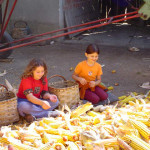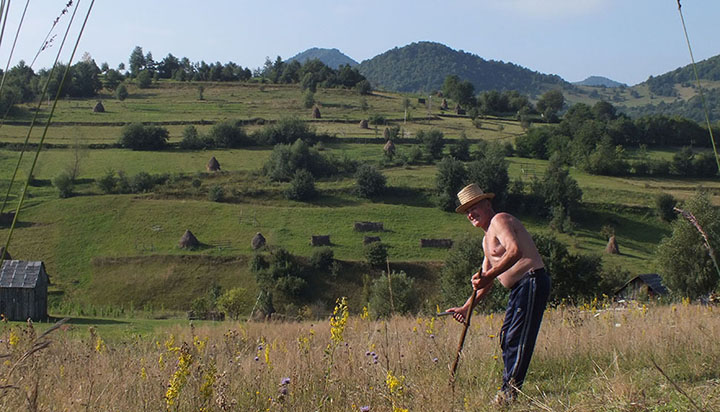The term biodiversity has been defined in many ways, using many measures such as relative species richness, interspecies abundance, or the role of biodiversity in healthy ecosystems. As human impact on ecosystems and species increases, the search for ways to analyze a broadly conceived human/environment interaction becomes more urgent. Recent developments in anthropology and geography, and especially in specialties of ethnology and ethnobiology, have added a new term, biocultural diversity. It is defined as diversity of life in all its manifestations—biological, cultural, and linguistic—which are interrelated (and likely co-evolved) within a complex socio-ecological adaptive system. Like biodiversity, this new term requires the development of new forms of data acquisition, new measures for analysis, and novel applications to management and policy. In uncertain times, a multiplicity of strategies and methods are as important as the diversity of species and habitats in ensuring local-to-global food production.
A Comprehensive Toolbox for Studying Biocultural Diversity
Historical ecology, one of the foundations upon which the work of CBM is based, is a practical framework of concepts and methods for studying the past and future of the relationship between people and their environment. While historical ecology may be applied to spatial and temporal frames at any resolution, it finds particularly rich sources of data at the “landscape” scale, where human activity and cognition interact directly with biophysical systems, and where archaeological, historical, ethnographic, environmental, and other records are plentiful. Fundamental to the practice of historical ecology are three broad goals: integration of data into a system-wide framework, collaboration among involved parties, and application of this new knowledge to a sustainable future. (See box for further reading on these three goals).
Thus historical ecology provides a system-wide framework, along with the tools needed to construct an evidence-validated, evolving narrative of the evolution and transformation of specific landscapes, based on the region’s record of human activity and changing environments. Through this comprehensive understanding of contemporary landscapes’ past, historical ecology offers place-based insights, models, and ideas for their sustainable future.
The perspectives and methods of historical ecology, offering a holistic approach, integrated data acquisition, multi-faceted analysis, and engagement with communities of practice, can examine biocultural diversity and articulate novel management and policy applications.
Biocultural Diversity and Food Production
In the near future our planet will need to feed nine billion human beings, but in landscapes of food-feed-fiber-fuel production the loss of biodiversity is accelerating. The Convention on Biological Diversity calls for a reduction of modern agriculture’s pressure on biodiversity, but how can this goal be achieved? In the future, conditions (affecting soil, temperature, rainfall and more) that are necessary for successful cultivation will continue to vary widely; historical patterns of land use and new conditions of geography and climate will always combine to necessitate novel practices. While it is easy to criticize contemporary agriculture for decreasing biodiversity, agriculture itself does not invariably lead to its loss.
To ensure a sustainable food supply into an uncertain future, is not enough to save seeds (e.g., the Svalberg seed vault in Norway) or to modify plants to withstand varying conditions (genetic modification); knowledge of management practices that maintain and augment biodiversity must also be safeguarded. A prudent approach to the issue would then require a diversity of management strategies; their careful observation can lead to increasingly sustainable practices.
A practical and low-cost means to collect this information is to learn from people whose practices can increase biodiversity. Such knowledge is termed Traditional Environmental Knowledge (TEK). Archaeological, historical, and paleoecological data indicate that, in many regions of the world, agricultural practices significantly increased biodiversity. In addition, the traditional practices of many contemporary societies have been extensively studied and demonstrate their great value to biodiversity conservation. Valuable information about how this has been achieved is widely available and permits the investigation of sustainable practices in both the past and the present.
Sustainable agriculture employs fundamental principles of ecology in an integrated system of place-based plant and animal production that will last over the long term. Rising interest in sustainable agriculture (such as permaculture, organic farming, agroforestry, ecoagriculture, Satoyama, and other management strategies) demonstrates how traditional practices are employed and augmented with new ideas and technologies. Thus there are many examples of how agriculture can be practiced to enrich species diversity and abundance and also to increase yields.
My colleagues and I suggest an important way to ensure biodiversity by safeguarding local knowledge in places where, in contrast with much of contemporary agriculture, local and regional smallholder practices have increased species diversity. We term these places biocultural refugia. In ecology, refugia are places where relict (meaning formerly more widespread or abundant) species have found shelter during periods of stress.
 Bilderna visar hur det kan se ut på en familjegård i Štitar, Kroatien. Familjen arbetar tillsammans med att skala och lägga upp lager av majs som skördats. En kvinna bakar i en utomhusugn.
Bilderna visar hur det kan se ut på en familjegård i Štitar, Kroatien. Familjen arbetar tillsammans med att skala och lägga upp lager av majs som skördats. En kvinna bakar i en utomhusugn.The photo show what it can look like on a family farm in Croatia. A family is pulling labour together to shuck and store corn in Stitar, Croatia.
Foto: Laura Lilly
Examples of contemporary biocultural refugia can be found in Croatia. In the village of Štitar, located in the Salvonia region in eastern Croatia, family farmers are close to the ideal of the European Union’s Common Agricultural Policy (CAP) of socially sustainable farmers: competitive stewards of the environment. They offer a vision of the future that combines high production levels and enhanced biodiversity. These family farms have survived over the years, transmitting experience from generation to generation despite a turbulent history of despotic regimes, wars, and economic policies that do not favor small farmers. As Croatia prepared for a mid-2013 entry into the European Union, a year-long study of family farms was undertaken in Štitar by Dominkovic in 2007.
Policy makers and the general public often think of smallholders as backward, unproductive, inefficient, and resistant to change; Dominkovic’s painstaking research dismantles this stereotype. Štitar’s households’ managerial skills contribute to their farms’ long-term resilience. These farmers are both market oriented and subsistence focused, they diversify both plant production and animal husbandry, and they invest more labor hours. As a result, their production costs are lower, they achieve higher output per land unit than industrialized farms, and they maintain a mosaic landscape that holds a diversity of habitats and high levels of species richness. Dominkovic’s findings in Štitar support research elsewhere that traditional ecological knowledge can be combined successfully with competitiveness in a market economy.
Biocultural refugia serve not only as a resource for holistic management strategies, but are also quite literally refuges for beneficial species and established ecosystems. Sustainable management practices, learned from smallholders and contemporary sustainability initiatives, have great potential for application at broader scales. What is essential is practical knowledge—rarely written down but available orally and, through reconstruction, in documents and from evidence in the ground itself. Agriculture, from its beginnings nearly ten thousand years ago, has always been a human endeavor, combining species’ genetic modification, intimate regional knowledge of local environments, and complex planning and scheduling.
 Biokulturella refugier fungerar som fristäder för arter och ekosystem, men också som resurser för förvaltningsstrategier. Forskning visar att visar att traditionell ekologisk kunskap hos småjordbrukare framgångsrikt kan kombineras med konkurrenskraft i en marknadsekonomi. Bilden är från Botiza i Rumänien.
Biokulturella refugier fungerar som fristäder för arter och ekosystem, men också som resurser för förvaltningsstrategier. Forskning visar att visar att traditionell ekologisk kunskap hos småjordbrukare framgångsrikt kan kombineras med konkurrenskraft i en marknadsekonomi. Bilden är från Botiza i Rumänien.Biocultural refugia are an important way to ensure biodiversity by safeguarding local knowledge in places where, in contrast with much of contemporary agriculture, local and regional smallholder practices have increased species diversity. In ecology, refugia are places where relict (meaning formerly more widespread or abundant) species have found shelter during periods of stress. The photo is from Botiza in Romania.
Foto: Håkan Tunón
Not every part of the world can benefit from a single model of agricultural practice. Climate, terrain, social preferences and constraints, and many more factors make each region different. Many societies practice forms of agriculture that are better suited to their regions than are industrial forms; these societies can continue to feed their populations as before, putting minimal strain on global food security and reducing household debt. The future may not find everyone living in crowded cities where they must rely on long supply chains. It is both prudent and practical to ensure that there is great diversity in the ways we feed ourselves.
Biocultural refugia remind us that there is much to learn from historic and contemporary smallholder and management strategies and specific practices that are sustainable and can be “scaled up” to meet future needs. The holistic perspective and practical approach of historical ecology can be found in many of CBM’s research projects, gaining on-the-ground ecological knowledge from reindeer herders in northern Sweden, farmers in highland Romania, and many other regions.
Further reading:
Barthel, Stephan, Carole L. Crumley, and Uno Svedin (2013a), Bio-Cultural Refugia: Safeguarding Diversity of Practices for Food Security and Biodiversity. Global Environmental Change 23(5):1142-1152.
http://dx.doi.org/10.1016/j.gloenvcha.2013.05.001
(2013b), Bio-cultural refugia: combating the erosion of diversity in landscapes of food production.Ecology and Society, 18(4)71.
Baleé, William and Clark Erickson (2006), Time and Complexity in Historical Ecology: Studies in the Neotropical Lowlands. New York: Columbia University Press.
Dominkovič, Katarina Laura (2007), Traditional Agriculture and Rural Living in Croatia: Compatible with the new Common Agricultural Policy? Doctoral Dissertation, Department of Anthropology, University of North Carolina, Chapel Hill N.C. (USA).
Gomez-Baggethun, Erik, Reyes-García, V., Olsson, P., Montes, C.(2012), Traditional ecological knowledge and community resilience to environmental extremes: A case study in Doñana, SW Spain. Global Environmental Change 22:640- 650.
Netting, Robert McCormick (1993), Smallholders, Householders: Farm Families and the Ecology of Intensive, Sustainable Agriculture. Stanford: Stanford University Press.
Reyes-García, V., V. Vadez, T. Huanca, W.R. Leonard, and T. McDade (2007), Economic development and local ecological knowledge: a deadlock? Data from a native Amazonian society. Human Ecology 35:371-377.
Seitzinger, Sybil P., Uno Svedin, Carole L. Crumley, Will Steffen, Saiful Arif Abdullah, Christine Alfsen, Wendy J. Broadgate, Frank Biermann, Ninad R. Bondre, John A. Dearing, Lisa Deutsch, Shobhakar Dhakal, Thomas Elmqvist, Neda Farahbakhshadad, Owen Gaffney, Helmut Haberl, Sandra Lavorel, Cheikh Mbow, Anthony J. McMichael, Joao M. F. deMorais, Per Olsson, Patricia Fernanda Pinho, Karen C. Seto, Paul Sinclair, Mark Stafford Smith, Lorraine Sugar. (2012), Planetary Stewardship in an Urbanizing World: Beyond City Limits. AMBIO 41(8):787-794. DOI 10.1007/s13280-012-0353-7
